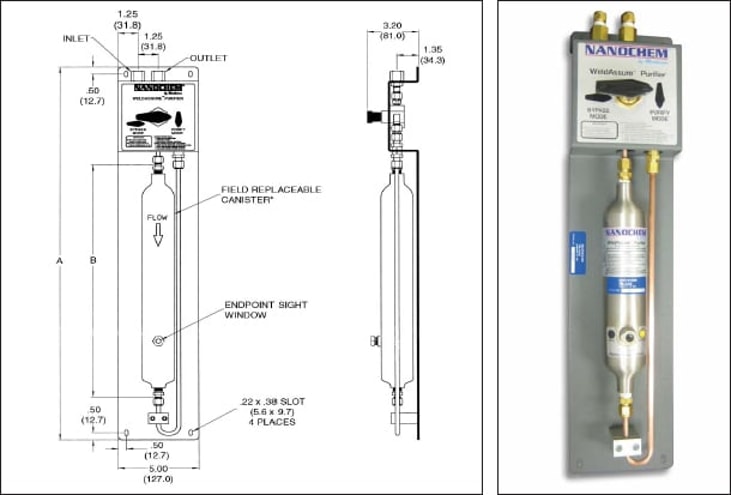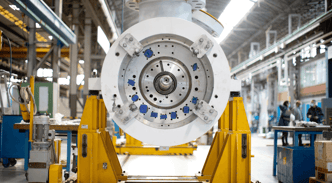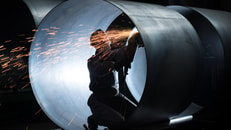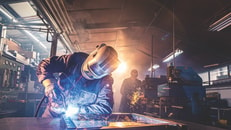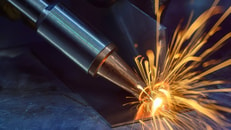Getting It Right – The Critical Role of Gases in Today’s Welding Applications
Gases are a very important part of the welding process, and understanding their use, specifications, and quality is critical to metal arc welding. The volumes and requirements for high quality welding are increasing. Demand is being driven by NASA, defense contractors, the nuclear industry, and high technology equipment manufacturers that require the highest quality welded systems and components.
Welders are also calling for lower scrap and rework, and clean X-ray micrographs. This increasing demand for high quality welding and more precise production techniques makes indepth understanding of shielding gases and their purification requirements more important than ever. While the main role of shielding gases is to eliminate oxides in the weld, they also are used to remove atmospheric impurities from the metal surface during the welding process. Shielding gases also improve the characteristics of the welding arc, the “puddling” of the weld metal, the penetration of the weld bead, the speed of laying down the weld, and the quality of the weld. Gases also enhance the mechanical properties of the weld, such as strength and ductility. When metal is formed without a shielding gas, oxides such as carbon dioxide or carbon monoxide are formed and can lead to problems with the welds, including porosity and slag formation. (Reference: Anderson, T., “Making the Switch to Aluminum Welding,” Practical Welding Today, pg 42–47, November-December 2000.)
High Quality Welding and Purifiers
Where high purity is critical to the weld, industry is increasingly relying on gas purifiers to ensure that gases have low or no contaminants. In the past, welding gas purification techniques were based on a very expensive zirconium getter. They were used in only a few highly specialized welding applications, like the welding of aircraft and rocket sub-assemblies from common metals such as aluminum, titanium, and stainless steel, or more unusual metals, such as columbium (also known as niobium). For these specialized welds, companies like United Launch Alliance (Lockheed & Boeing Joint Venture), Lockheed Martin, NASA, and other aerospace contractors, used MATHESON’s NANOCHEM® purifiers, first introduced in 1985. These purifiers provided the equivalent of ultra high purity shielding gases at the welding torch tip. Companies like these had purifiers on their production lines and considered them an integral part of their welding process and standard operating procedure. Some customers relied exclusively on purifiers for gas-line purity, considering them essential for quality control. Today, NANOCHEM® purifiers are considered state-of-the-art and continue to be used in the aerospace industry. The demand for purifiers has greatly expanded with the growth of semiconductor, nuclear, and biotech applications. NANOCHEM® purifiers completely remove contaminants, such as oxygen, moisture, carbon dioxide, and hydrocarbons (compressor oils), from shielding gases to part-per-billion levels at the outlet of the purifier; the dew point of the purified gas is below -150ºF. Benefits of gas purifiers include elimination of surface oxides and porosity, clean X-rays, smooth weld surfaces, excellent wetting, good cleaning action, stable arc, and protection of the tungsten tip from erosion (TIG) and weld contamination. The reduction in rework and rejects alone typically pays for the purifier. The purifiers also provide insurance against gas delivery upsets, such as a bad cylinder or a sudden leak in the gas line. Purifiers also provide purge and shield gas purification for welding applications. As discussed, weld gas impurities, such as moisture and oxygen, adversely affect weld quality. These impurities are present in gas cylinders and can also be introduced through leaks in the line or during cylinder changes. Purifiers remove most contaminants completely without introducing any other compounds. The only by-product formed by the purifier is trace hydrogen gas generated from the removal of moisture. One (1) ppm of moisture in the feed gas creates about two-thirds ppm of hydrogen gas after passage through NANOCHEM® OMX™ media.
These impurities are present in gas cylinders and can also be introduced through leaks in the line or during cylinder changes.
As discussed, the benefits to purifying welding gas are quite significant, particularly for high quality welds. Without a cleaning process, quality welds in reactive materials like aluminum, magnesium, titanium, and stainless steel are impossible. However, the problems present on and in the metal to be welded and on the filler rods need to be addressed as well. The welder must make sure the surfaces and welding rods are mechanically cleaned. Metal surfaces and welding rods need to be cleaned with acetone to remove oils and heavy hydrocarbons. The tips of aluminum welding rods need to be snipped back just prior to welding, to get rid of that large chunk of potential oxide. Then sources of potential contaminants, like dirty gloves, torch cups, parts, and tools, and contaminated tungsten tips must be cleaned and constantly monitored. Any wind gusts or air breezes that might contaminate the shielding gas at the puddle must be eliminated also. After these significant steps are completed, the quality of the argon gas becomes the one large problem that cannot be solved without a purification system.
... to continue reading you must be subscribed

